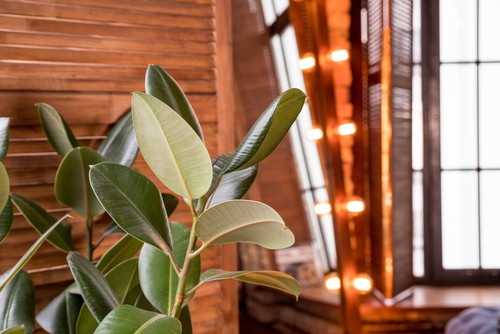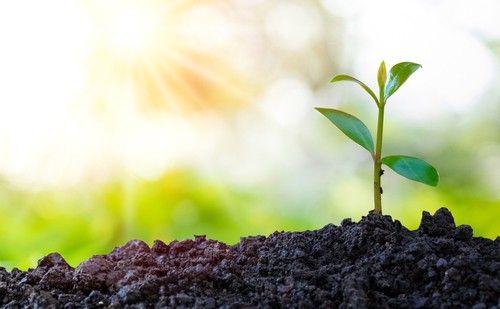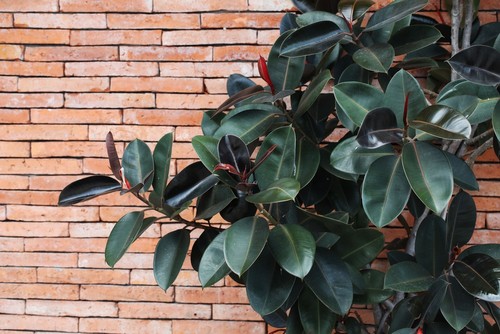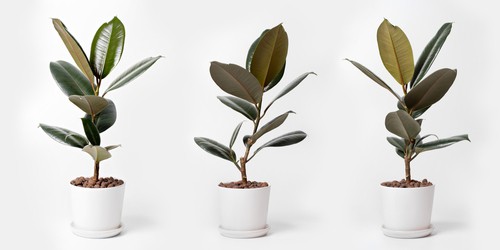Rubber plants are a popular choice for indoor plant enthusiasts, thanks to their attractive foliage and easy-to-care-for nature. However, one common issue that many rubber plant owners face is the development of brown spots on the leaves.
These spots can be unsightly and may indicate an underlying problem that needs to be addressed.
Understanding why your rubber plant have brown spots is key to preventing and treating the issue. Some of the most common causes include watering issues, light and temperature factors, humidity problems, nutrient deficiencies, and pest and disease infestations.
By identifying the root cause of the problem, plant owners can take steps to correct the issue and restore their rubber plant to health.
Key Takeaways:
- Brown spots on rubber plants are a common issue that can be caused by a variety of factors.
- Understanding the cause of the brown spots is key to preventing and treating the issue.
- Common causes of brown spots on rubber plants include watering issues, light and temperature factors, humidity problems, nutrient deficiencies, and pest and disease infestations.
More on this category:
- Why Does My Prayer Plant Have Yellow Leaves?
- Why Does My Monstera Plant Have Water Droplets?
- Why Does My Mint Plant Keep Dying?
Understanding Rubber Plant

Rubber plant, also known as Ficus elastica, is a popular houseplant known for its large, glossy, and attractive leaves. It is a low-maintenance plant that can thrive in a variety of environments, making it a popular choice for both novice and experienced gardeners.
Rubber plants are native to Southeast Asia and are commonly found in tropical rainforests. They can grow up to 100 feet tall in their natural habitat, but when grown as a houseplant, they typically reach a maximum height of 8-10 feet. The plant’s leaves are thick and waxy, which helps it retain moisture and gives it a shiny appearance.
Rubber plants are known for their air-purifying qualities, making them a great addition to any indoor space. They are also known for their ability to adapt to different lighting conditions, although they prefer bright, indirect light.
When it comes to watering, rubber plants prefer to be kept moist but not overwatered. Overwatering can cause the plant’s leaves to turn yellow and brown, which is a common problem that many rubber plant owners face.
In terms of care, rubber plants are relatively easy to maintain. They do not require frequent fertilization and can go several months without being repotted. However, like any plant, rubber plants are susceptible to pests and diseases, which can cause brown spots to appear on their leaves.
Understanding the common causes of brown spots on rubber plant leaves is essential to maintaining the plant’s health and appearance.
Why Does My Rubber Plant Have Brown Spots – 3 Common Problems
Rubber plants are known for their large, glossy leaves that can add a touch of tropical beauty to any indoor space. However, if you notice brown spots on your rubber plant leaves, it can be a sign that something is wrong. Here are some common problems and causes that may lead to brown spots on rubber plant leaves:
1. Environmental Stressors
Temperature changes, dry air, and overwatering are some of the most common environmental stressors that can cause brown spots on rubber plant leaves. If the air in your home is too dry, it can cause the leaves to turn brown and dry out.
Similarly, if the plant is exposed to temperature fluctuations, it can lead to discoloration and brown spots. Overwatering can also be a problem, as it can cause the roots to rot and the leaves to turn yellow and brown.
2. Nutrient Deficiencies

Rubber plants need a balanced mix of nutrients to thrive, and if they are not getting enough of certain nutrients, it can lead to brown spots on the leaves. For example, if the plant is not getting enough nitrogen, the leaves may turn yellow and develop brown spots.
Similarly, if the plant is not getting enough magnesium, the leaves may develop brown spots and curl up.
3. Pests and Diseases
Rubber plants are susceptible to a variety of pests and diseases, and if left untreated, they can cause brown spots on the leaves. For example, spider mites can cause brown spots and webbing on the leaves, while scale insects can cause yellowing and brown spots.
Fungal diseases such as powdery mildew and bacterial blight can also cause brown spots on rubber plant leaves.
Watering Issues
Rubber plants are susceptible to a variety of watering problems that can cause brown spots on their leaves. Proper watering is crucial for the health of rubber plants, as they require consistent moisture to thrive.
In this section, we will discuss the two most common watering issues that can cause brown spots on rubber plant leaves: overwatering and underwatering.
Overwatering
Overwatering is a common problem that can cause brown spots on rubber plant leaves. When rubber plants are overwatered, their roots become waterlogged, which can lead to root rot. This can cause the leaves to develop brown spots, wilt, and eventually fall off.
To prevent overwatering, it is important to ensure that the rubber plant is planted in a pot with good drainage. A quick-draining soil mix can also help to prevent water from accumulating in the soil.
It is also important to avoid watering the plant too frequently, as this can lead to waterlogged soil. In general, rubber plants should be watered once every 7-10 days, depending on the humidity and temperature of the environment.
Underwatering
Underwatering is another common problem that can cause brown spots on rubber plant leaves. When rubber plants are underwatered, they can become dehydrated, which can cause the leaves to turn yellow and develop brown spots. In severe cases, the leaves may fall off the plant.
To prevent underwatering, it is important to ensure that the rubber plant is watered regularly. Rubber plants prefer moist soil, so it is important to water them when the top inch of soil feels dry to the touch. It is also important to use room temperature tap water, as cold water can shock the roots of the plant.
Light and Temperature Factors

Light Requirements
Rubber plants require bright, indirect light to thrive. Direct sunlight can cause sunburn on the leaves, which appears as brown spots. If the plant is not receiving enough light, it can also develop brown spots. Therefore, it is recommended to place the rubber plant near a window that receives bright, indirect light.
If the plant is placed too far from the window, it may not receive sufficient light, and if it is placed too close to the window, it may receive too much direct sunlight.
Temperature Needs
Rubber plants prefer warm and consistent temperatures. Sudden temperature changes can cause stress on the plant, leading to brown spots on the leaves. It is recommended to keep the temperature between 60-80°F (15-27°C) and avoid placing the plant near drafty windows or doors.
If the rubber plant is placed in a room with low humidity, it may also develop brown spots.
Humidity and Its Effects
Rubber plants require high humidity levels to thrive. Humidity is the amount of moisture present in the air. It can have a significant impact on the health of your rubber plant. In this section, we will discuss the effects of both low and high humidity on your rubber plant.
Low Humidity
If the humidity level is too low, the leaves of your rubber plant can become dry and brittle. This can lead to brown spots on the leaves. Low humidity can also cause the tips of the leaves to turn brown and curl up.
To avoid this, you can use a humidifier to increase the humidity level around your plant. Alternatively, you can place a tray of water near the plant. As the water evaporates, it will increase the humidity level in the room.
High Humidity
While rubber plants prefer high humidity levels, too much humidity can also be harmful. High humidity can cause the leaves of your rubber plant to turn yellow and become mushy. This can lead to fungal growth and other diseases.
To avoid this, make sure that the humidity level is not too high. If you live in a humid climate, consider using a dehumidifier to reduce the humidity level in the room.
Nutrient and Soil Requirements

Rubber plants require adequate nutrition to grow healthy and strong. Without the right nutrients, the plant may develop brown spots on its leaves. It is essential to provide the plant with the right soil and fertilizers to ensure it gets the necessary nutrients.
1. Soil Requirements
Rubber plants require well-draining soil that contains organic matter. The soil should be rich in nutrients and have good aeration. The roots of the plant require oxygen to grow and absorb nutrients. If the soil is too compact, it can prevent the roots from getting enough oxygen, leading to brown spots on the leaves.
To ensure the soil has good aeration, it is recommended to add perlite or vermiculite to the soil mix. These materials help to improve drainage and prevent the soil from becoming too compact.
2. Fertilizer Requirements
Rubber plants require regular fertilization to ensure they get the necessary nutrients. It is recommended to fertilize the plant every two weeks during the growing season, which is typically spring and summer.
When selecting a fertilizer, it is essential to choose one that is high in nitrogen. Nitrogen is essential for the growth and development of the plant. However, it is important not to over-fertilize the plant as this can lead to leaf burn and brown spots.
3. Root Health
The health of the roots is essential for the overall health of the plant. If the roots are unhealthy, the plant may not be able to absorb nutrients properly, leading to brown spots on the leaves.
To ensure the roots are healthy, it is recommended to check the soil moisture regularly. Overwatering can lead to root rot, while underwatering can cause the roots to dry out and die. It is also recommended to repot the plant every two to three years to ensure the roots have enough space to grow.
Pest and Disease Management
Rubber plants are susceptible to pests and diseases, which can cause brown spots on the leaves. Proper pest and disease management is crucial to maintain the health and appearance of rubber plants.
Common Pests

Rubber plants can be infested by several sap-sucking pests, including spider mites, scale, and thrips. These pests can cause damage to the leaves, resulting in brown spots.
To manage these pests, it is recommended to use neem oil, which is a natural insecticide. Apply the neem oil to the affected leaves, making sure to cover both the top and bottom surfaces. Repeat the application every two weeks until the pests are eliminated.
Common Diseases
Rubber plants can also be affected by fungal and bacterial infections, which can cause brown spots on the leaves. Anthracnose, alternaria, and septoria leaf spot are common fungal diseases that affect rubber plants. These diseases can cause mold-like growth on the leaves, leading to brown spots.
To manage these diseases, cut off the affected leaves and disinfect the pruning shears with chlorine or fluoride to prevent the spread of the disease.
Root rot is another common disease that affects rubber plants. This disease is caused by overwatering, which leads to mushy and discolored roots. To manage root rot, it is recommended to reduce watering and allow the soil to dry out between waterings. If the plant is severely affected, it may need to be repotted in fresh soil.
Cephaleuros virescens, also known as algal leaf spot, is a fungal disease that affects rubber plants. This disease causes rust-colored spots on the leaves, which can lead to brown spots. To manage this disease, it is recommended to prune affected leaves and disinfect the pruning shears to prevent the spread of the disease.
Environmental stressors, such as insufficient light and dry air, can also cause brown spots on rubber plant leaves. It is important to provide the plant with the appropriate amount of light and humidity to prevent stress. Regularly inspecting the plant for pests and diseases can help prevent harm to the plant and maintain its health.
Plant Care and Maintenance
Rubber plants are easy to care for and maintain, making them a popular choice for houseplants. Follow these tips to keep your rubber plant healthy and vibrant:
- Light: Rubber plants prefer bright, indirect light, but can tolerate some direct sunlight. Avoid placing them in low light conditions as this can cause the leaves to turn brown and fall off.
- Watering: Water your rubber plant when the top inch of soil is dry to the touch. Overwatering can lead to root rot and brown leaves, while underwatering can cause the foliage to dry out and turn brown.
- Humidity: Rubber plants prefer high humidity, so consider using a humidifier or placing a tray of water near the plant to increase the moisture in the air.
- Fertilizer: Feed your rubber plant with a balanced fertilizer every two weeks during the growing season (spring and summer). Do not fertilize during the winter months when the plant is dormant.
- Repotting: Rubber plants should be repotted every 2-3 years to provide fresh soil and room for new growth. Choose a pot that is one size larger than the current one and use a well-draining potting mix.
- Pruning: Prune your rubber plant to maintain its shape and remove any brown leaves or branches. Use clean, sharp scissors or pruning shears to make clean cuts.
By following these care tips, your rubber plant should thrive and remain healthy with vibrant foliage.
Conclusion

Brown spots on rubber plants can be caused by a variety of factors, including fungal and bacterial infections, insect infestations, environmental stress, and improper care. It is important to identify the cause of the brown spots to effectively treat the issue and prevent further damage to the plant.
Some of the common causes of brown spots on rubber plants include fungal diseases such as Myrothecium, which causes dime-sized brown spots with spore structures forming in rings. Other fungal diseases that can cause brown spots include Anthracnose, Alternaria, Septoria Leaf Spot, Downy Mildew, and Powdery Mildew.
In addition to fungal diseases, brown spots on rubber plants can also be caused by environmental stressors such as temperature changes, dry air, and overwatering. Over-fertilization or under-fertilization can also cause brown spots on rubber plant leaves.
To prevent brown spots on rubber plants, it is important to provide adequate care by ensuring that the plant is placed in a warm and humid environment, and that it is watered properly.
It is also important to use the correct soil mix and fertilize the plant appropriately. Regularly inspecting the plant for signs of pests or diseases and addressing any issues promptly can also help prevent brown spots.
Frequently Asked Questions
How do I treat brown spots on my rubber plant leaves?
The treatment for brown spots on rubber plant leaves depends on the cause. If the spots are due to overwatering, it is important to cut back on watering and allow the soil to dry out before watering again.
If the spots are due to a fungal or bacterial infection, it may be necessary to use a fungicide or bactericide to treat the plant. In some cases, it may be necessary to prune the affected leaves to prevent the spread of the infection.
What causes brown spots on rubber plant leaves?
Brown spots on rubber plant leaves can be caused by a variety of factors, including overwatering, underwatering, low humidity, pests, and diseases. Environmental stressors such as temperature changes, dry air, and over-fertilization can also cause brown spots on rubber plant leaves.
Can overwatering cause brown spots on rubber plant leaves?
Yes, overwatering can cause brown spots on rubber plant leaves. When the soil is too moist, it can lead to root rot, which can cause the leaves to turn brown and fall off. It is important to allow the soil to dry out between waterings to prevent overwatering.
What are some common diseases that cause brown spots on rubber plant leaves?
Some common diseases that cause brown spots on rubber plant leaves include algal leaf spot, alternaria, anthracnose, septoria leaf spot, downy mildew, and powdery mildew. Each of these diseases has its own set of symptoms and treatment options.
Are brown spots on rubber plant leaves harmful to the plant?
Brown spots on rubber plant leaves can be a sign of stress or disease, but they are not necessarily harmful to the plant. In some cases, the plant may be able to recover on its own if the underlying cause of the brown spots is addressed.
However, if the spots are due to a serious disease or pest infestation, it may be necessary to take more aggressive measures to protect the plant.
Should I prune brown leaves on my rubber plant or wait for them to fall off naturally?
It is generally recommended to prune brown leaves on a rubber plant rather than waiting for them to fall off naturally. Pruning the affected leaves can help prevent the spread of disease and promote new growth.
However, it is important to use clean, sharp pruning shears and to disinfect them between cuts to prevent the spread of disease.

Hey, I’m Lisa and I’ve been an avid gardener for over 30 years. I love writing, talking and living in the garden! Feel free to connect with me on my socials below


